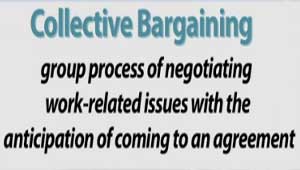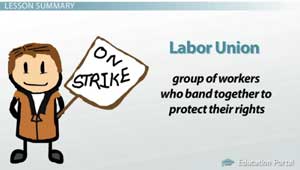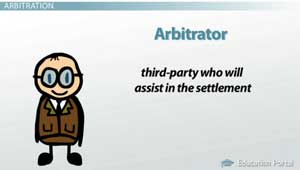Function of Collective Bargaining
After you watch the video and know the material, click HERE for the quiz.
The function of collective bargaining is to negotiate work-related issues. Bargaining or negotiating takes place between the employer and the employees. The employees are represented by a collective bargaining unit.
Collective Bargaining Function
 |
In this lesson, we will explore the function of collective bargaining and the parties it serves. Collective bargaining is a group process of negotiating work-related issues with the anticipation of coming to an agreement. Bargaining or negotiating is done between two parties: the employer and the employees. The employees are represented by a collective bargaining unit. Employees form a union, which is a group of workers who band together to protect their rights.
 |
Unions and management use collective bargaining to:
- Settle disputes and grievances
- Preserve employee rights
- Negotiate contracts, salaries and benefits
- Ensure safe working conditions and job safety
Collective Bargaining Process
The process of collective bargaining is simple. The parties will prepare, discuss, propose, bargain or negotiate and settle. Let's take a visit to Lenny's Trans-Atlantic Shipping Company. Lenny's employees are known as longshoremen. These are employees who load and unload ships. The longshoremen are part of a large union called the United Longshoremen of America. Lenny and his employees are at odds about a pay raise. Lenny and the union are going to meet soon to discuss the pay raise. Each party will follow the collective bargaining process to negotiate the pay raise.
In the first step - prepare - a team of representatives is assembled to represent both parties. During this step, both representative groups will prepare for the negotiations. Depending on the type of negotiations, various documents will be compiled. Because Lenny and the union are negotiating pay raises, the parties will bring supporting information to strengthen their argument. For example, Lenny may bring a profit and loss statement to prove he cannot afford raises. The union representatives may bring data on rising costs of living, proof that a similar company pays employees at a higher rate or data on industry standard pay rates.
In the next step - discuss - the two parties meet at a neutral site to talk about the issues at hand. The parties are generally required to meet at a neutral location to avoid one party being more comfortable or have a stronger support system than the other. Meeting on the docks near Lenny's company may be in the best interest of the union, but it would leave Lenny with few supporters. It can create a stressful and, in the worst case, even hostile environment. The parties should meet in a neutral place, like a nearby luncheonette.
 |
The third step - propose - involves one or both parties formally recommending a solution to the issue at hand. The proposal must be in specific language. Lenny's longshoremen want to make $3.00 more per hour. The union representatives must provide Lenny and his representatives with the exact dollar amount. In this case, the representatives drafted the proposal with the dollar amount included.
Next, the parties will bargain or negotiate, and this involves making offers and counter-offers. Each party will present their rationale for the solution. Negotiations between Lenny and the union representatives were heated. Lenny negotiated a raise of $2.00 per hour. The representatives wanted to negotiate $3.00 per hour. This went on for several hours.
Finally, it is the hopes of both parties that they will settle, or come to an agreement on the issue that is at the best interest of both parties. However, both parties do not always settle.
Going on Strike
Not all negotiations settle. If the union does not feel satisfaction with the negotiations, the employees may go on strike. A strike is a mass work stoppage. Employees refuse to perform their job until their issue is resolved. When this happens, a third party may be called in to assist in the negotiations.
Unfortunately, Lenny's longshoremen went on strike. They paced the docks with signs stating their issue. Their strike meant that the ships were not being loaded or unloaded. The imports and exports were at a stand still.
Arbitration
 |
Sometimes, an arbitrator is called to act as a third party who will assist in the settlement. The arbitrator acts as an alternate conflict resolution facilitator. There are two ways in which this is done: voluntary and involuntary.
Voluntary means both parties agree to allow the arbitrator to hear both sides of the issue and make suggestions for settlement. This means both parties knew that they could not come to a negotiation. They agreed to allow a third party to listen and decide for them.
Involuntary means one or both parties did not agree to allow an arbitrator to hear the issue. A court could force the parties to allow an arbitrator to hear the issue. This happens in cases where the issues are either too complex to be resolved by the parties or the parties just cannot get along.
The arbitrator's decision can impact the settlement in two ways: non-binding and binding.
 |
In a non-binding decision, the arbitrator's decision is considered advisory and is not enforceable against the party or parties. This means the arbitrator is simply giving his opinion on the settlement and by no means does it hold any legal power over the parties. With a binding decision, the arbitrator's decision is legally binding and enforceable. This means the arbitrator's decision must stand.
The work stoppage at Lenny's shipping company caused chaos on the docks. Food was spoiling on the incoming ships. Export products were sitting in cargo waiting to move to their destinations. It was a disaster. The local government stepped in and demanded that both parties use an arbitrator to help sort out the issues. Further, the government official required mandatory/binding arbitration. This meant that Lenny and the union representatives had to allow an arbitrator to make a binding or enforceable decision about the pay increase. The arbitrator decided on a pay raise of $2.75 per hour.
Lesson Summary
In summary, collective bargaining is a group process of negotiating work-related issues with the anticipation of coming to an agreement. Employees form a labor union, which is a group of workers who band together to protect their rights. The employer and the union follow the process of collective bargaining to settle issues. The process of collective bargaining involves steps. Each party will:
- Prepare by assembling a team of representatives to represent both parties.
- Discuss the issues by having the two parties meet at a neutral site.
- Propose a solution by having one or both parties formally recommend a solution to the issue at hand.
- Bargain or negotiate by making offers and counter-offers.
- Settle or come to an agreement on the issue that is in the best interest of both parties.
As we learned from Lenny's negotiations, some issues are not easily resolved. Sometimes employees go on strike. A strike is a mass work stoppage. When this happens, an arbitrator is called to act as a third party who will assist in the settlement. The arbitrator can be voluntarily or non-voluntarily brought in to settle the issue. His decision can either be non-binding (an advisory decision) or binding (an enforceable decision).